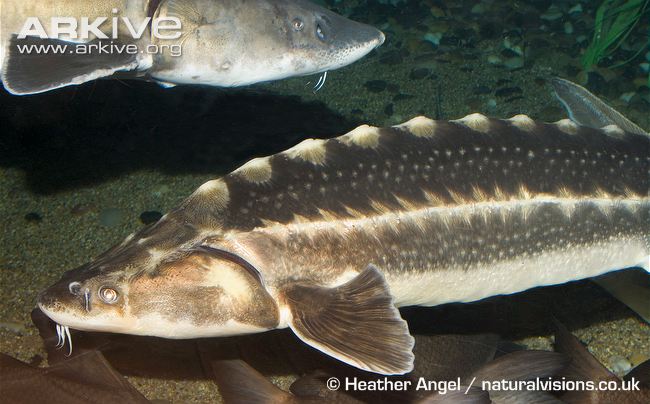The Scientific Name : Acipenser gueldenstaedtii
Where is it found?
The Russian is currently found the Caspian Sea and the Black Sea. In the Caspian sea region it spawns in the rivers Ural and Volga, where in the Black Sea spawning occurs in the lower Danube and Rioni rivers. Once it was found in abundance in the Azov Sea basins, which is now considered as extinct as no known native spawning population is there in that region. The species prefers shallow water of the coastal sea and deep regions of large rivers where the current is strong.
How does it live?
The Russian Sturgeon feeds on a wide variety of benthic molluscs, crustaceans and small fish. Males attain maturity at around 8 years, while females at around 10 years. The females reproduce every 4-6 years while males 2-3 years. This long reproduction cycle is a major threat for the fish. After maturity they migrate from the sea to the fresh water rivers into several hundred kilometers. It usually happens in the Autumn of in the Spring when the temperature rises above 10 deg C. Juveniles mostly spend their years in the sea till they attain maturity.The maximum age ever recorded of a Russian Sturgeon is 48 years.
How does it look?
Russian Sturgeon is a gigantic fish usually reaches a length of 2 meters and weight more than 100 kg. The juveniles look beautiful with white diamond like scales that become grey with age. They grow very fast, 1 ft/year, for initial few years. Body Of the Russian Sturgeon is spindle-shaped and proportionally wide. Dorsal scutes can range from 8 to 18, lateral scutes 24-50 and ventral scutes 6-13. It differs from other species of the Acipenser genera by its short snout with rounded tip, as well as by its lower lip, which is interrupted at its center. Barbells are not fringed, they are short, curved and situated near the top of the snout.
What are the threats?
The Russian Sturgeons are struggling hard to survive. The spawning grounds for the species have been lost to various large river dams created in the Danube, Don and Volga river. It is estimated that the species has lost more than 70% of its spawning grounds since 1950s. Annual catch for the fish has dropped drastically since 1980s from 90 – 100% i n most of the regions. Fishing, which is now strictly banned, is also one of the major threat to the fish currently. The caviar of the Russian sturgeon is one of the most sought after, and the flesh of the fish is also in demand always making poaching of the fish more frequent. High levels of pollution (from oil and industrial waste), in both the Black and Caspian Sea basins have altered hormonal balance, and increased the number of hermaphroditic fish. In 1990, 55,000 sturgeon were found dead on the shore of the Sea of Azov as the result of pollution.
Conservation Efforts
The fishing of Russian Sturgeon is made illegal many years ago in Russia and Iran both. But the enforcement of the law is not happening. The increasing demand is luring the poachers. General conservation measures for the fish is also weak or never applied. Fish lifts and artificial spawning grounds have been introduced to parts of the Caspian region without much success. The pollution level of the Caspian and Black sea have been decreasing in recent years, but the fish is still not out of danger from genetic deformation.
The Russian Sturgeon Conservation






Recent Comments